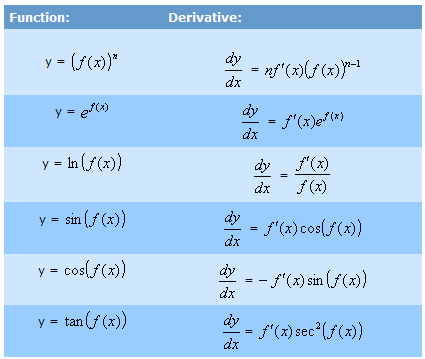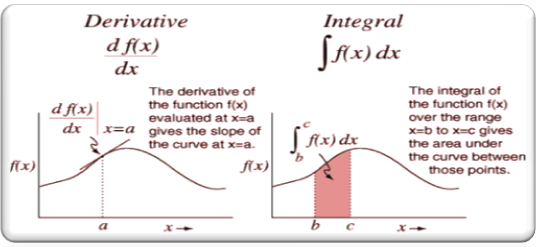Differentiation
Table of Content |
Derivatives
 Derivative is the rate of change in the slope of the curve of the function.
Derivative is the rate of change in the slope of the curve of the function.
Derivative can be finding using the formula,

At some places derivatives are also represented by fꞌ(x).
Differentiation
The process of finding a derivative is called Differentiation. Normally a dependent variable is expressed in terms of independent variables by means of an equation. Now when we find the differential coefficient of the dependent  variable with respect to the independent variable, what we do is we try to find out another equation by which the change in the dependent variable (for any infinitesimal change in independent variable) is relatable to the independent variable, whatever be the value of the independent variable.
variable with respect to the independent variable, what we do is we try to find out another equation by which the change in the dependent variable (for any infinitesimal change in independent variable) is relatable to the independent variable, whatever be the value of the independent variable.
Hence, derivative is a measure of how a function changes as its input changes. Informally, the derivative is the ratio of the infinitesimal change of the output over the infinitesimal change of the input producing that change of output. Geometrically, for a real valued function of a single real variable, the derivative at a point equals the slope of the tangent line to the graph of the function at that point. The process of finding a derivative is called differentiation.
In fact, differentiation and integration are the two fundamental operations in single-variable calculus. The figure given below illustrates the exact difference between integration and differentiation:
Notation
There are a number of ways of writing the derivative of a function. Though all these are same but it is essential to know them so as to avoid any kind of confusion:
Suppose we are finding the derivative of x2, then its derivative may be written as:
This says that the derivative of x2 with respect to x is 2x.
-
If f(x) = x2, f'(x) = 2x
This says that is f(x) = x2, the derivative of f(x) is 2x.
Geometrical Interpretation of Differentiation
Let y = f(x) be a function, and let P(a, f(a)) and Q(a+h, f(a+h)) be two points on the graph of the function that are close to each other. This graph is shown below:
Joining the points P and Q with a straight line gives us the secant on the graph of the function. And in the ?PQR, the gradient of the line is given by
m = {f(a+h) – f(a)}/(a+h-a) = {f(a+h) – f(a)} / h
In limiting process, i.e. as Q approaches P, h becomes really small, almost close to zero.
Hence, m = (change in y)/(change in x)
= {f(a+h) – f(a)} / h
lim h→0 (?y/?x) = {f(a+h) – f(a)} / h
As Q → P, the chord/secant PQ tends to be a tangent at P for the curve y = f(x). Thus the limiting becomes the slope of the tangent at P for y = f(x).
We denote lim h→0 (?y/?x) = dy/dx, and
lim h→0 [f(a+h) – f(a)]/ h = f’(a)
Therefore dy/dx = f’ (a) = m
Now, we have already seen that ‘m’ is the slope or gradient of the tangent at P for f(x).
f’(a) = tan θ = slope of f(x) at x = a.
Rules of differentiation
The differentiation of functions is carried out in accordance with some rules. These differentiation rules have been listed with the help of the following chart:
All these rules will be discussed in detail in the coming sections. Here, we shall give a brief outline of these rules:
(1) Constant rule:
If the function f is a constant, then its derivative is zero. Moreover if a function is multiplied by a constant then its derivative is given by
{cf(x)}' = cf'(X)
(2) Sum Rule:
{f(x) ± g(x)}' = f'(x) ± g'(x)
(αf + βg)' = αf' + βg' , for all functions f and g and real numbers α and β.
(3) Product Rule:
(fg)' = f'g + g'f, for all functions f and g.
(4) Quotient Rule:
(f/g)' = (f'g – fg')/g2, for all functions f and g such that g ≠ 0.
(5) Chain Rule:
If f(x) = h(g(x)), then f'(x) = h'(g(x)). g'(x)
|
(i) Express the original function as a simpler function of u, where u is a function of x. (ii) Differentiate the two functions you now have. Multiply the derivatives together, leaving your answer in terms of the original function (i.e. in x's rather than u's). |
Logarithmic Differentiation
To differentiate some special functions using logarithm is called Logarithm Differentiation. When it is difficult to differentiate the function then we use the differentiation using logarithms.
Logarithm Differentiation starts with taking the natural logarithm that is, logarithm to the base e on the both sides.
In order to compute the derivative of:
-
A function which is the product or quotient of a number of functions
y = g1(x)g2(x)g3(x) ….. or [(g1(x) g2(x) g3(x) ….) / (h1(x) h2(x) h3(x) ….)
-
A function of the form [f(x)]g(x) where f and g are both derivable, it is better to take the logarithm of the function first and then differentiate.
-
Or, we can write it as y = (f(x))g(x) = e g(x).ln f(x)?
Example
Differentiate y = xx
Solution:
y = xx
We will take the logarithm to both sides
In y = In xx
= x In x
Now we will differentiate both sides by using chain rule to the left-hand side as y represents a function of x and use the product rule on the right-hand side.

Multiply both sides with y
yꞌ = y (1 + In x)
= xx(1 + In x)
?We list below certain differentiation formulae for finding the derivative of functions:

Given below are some more formulae of some logarithmic and trigonometric functions:
Steps of Logarithm Differentiation
Logarithm Differentiation is the shortcut which helps in differentiating without using the product rule.

If we have to differentiate the above function then we don’t need to multiply it at all
Step 1: We can take the natural logarithm of both sides.

Step 2: use the product rule of the log.
loga(m × n) = logam + logan
So it will be like this

Step 3: Differentiate both sides using the chain rule of differentiation.

Step 4: Multiply both sides with f(x).

We now discuss some of the differentiation examples followed by some differentiation questions:
Illustration 1:
What is the gradient of the curve y = 2x3 at the point (3, 54)?
Solution:
The gradient of the curve is given by its derivative so the question actually requires you to compute the derivative.
The derivative is dy/dx = 6x2
When x = 3, dy/dx = 6 × 9 = 54.
Hence, the required gradient is 54.
________________________________________________________________________________
Illustration 2:
Find the derivative of 
Solution:
We will use the quotient rule to find the derivative.

Now we know that
 ……….(1)
……….(1)
 …….(2)
…….(2)
Hence, combining (1) and (2) we get the required answer.
_______________________________________________________________________________
Illustration 3:
Find the derivative of f(x) = x4 + sin (x2) – ln (x)ex + 7.
Solution:
Using the formulae, we get the derivative as

___________________________________________________________________________-
Illustration 4:
Find the derivative of (x2 + 5x – 3)/ 3 x½.
Solution:
This looks hard, but it isn't. The trick is to simplify the expression first: do the division (divide each term on the numerator by 3x½.
Doing this we obtain
(1/3)x3/2 + (5/3)x½ - x-½ (using the laws of indices).
So differentiating term by term: ½ x½ + (5/6)x-½ + ½x-3/2.


Q1. Both the derivative and the integral of this function are same
(a) the function is ex.
(b) the function is e2x.
(c) the function is 2ex.
(d) the function is ln x.
Q2. If f(x) = h(g(x)), then f'(x) =
(a) h'(g’(x)). g(x)
(b) h(g’(x)). g'(x)
(c) h'(g(x)). g(x)
(d) h'(g(x)). g'(x)
Q3. The derivative of logax is
(a) 1/x ln ax
(b) 1/x ln ax
(c) 1/x ln ax
(d) 1/x ln ax
Q4. The derivative of a constant function is
(a) zero
(b) the function itself.
(c) constant
(d) none of these
Q5. the derivative of the function [f(x)]n is
(a) n f(x)n (f’(x))
(b) n f’(x)n-1 (f(x))
(c) n f(x)n-1 (f’(x))


|
Q1. |
Q2. |
Q3. |
Q4. |
Q5. |
|
(a) |
(d) |
(b) |
(a) |
(c) |
Related Resources
-
You may wish to refer general theorems on differentiation.
-
Click here to refer the most Useful Books of Mathematics.
-
For getting an idea of the type of questions asked, refer the previous year papers.
To read more, Buy study materials of Methods of Differentiation comprising study notes, revision notes, video lectures, previous year solved questions etc. Also browse for more study materials on Mathematics here.
More Readings
View courses by askIITians


Design classes One-on-One in your own way with Top IITians/Medical Professionals
Click Here Know More

Complete Self Study Package designed by Industry Leading Experts
Click Here Know More

Live 1-1 coding classes to unleash the Creator in your Child
Click Here Know More

a Complete All-in-One Study package Fully Loaded inside a Tablet!
Click Here Know MoreAsk a Doubt
Get your questions answered by the expert for free



